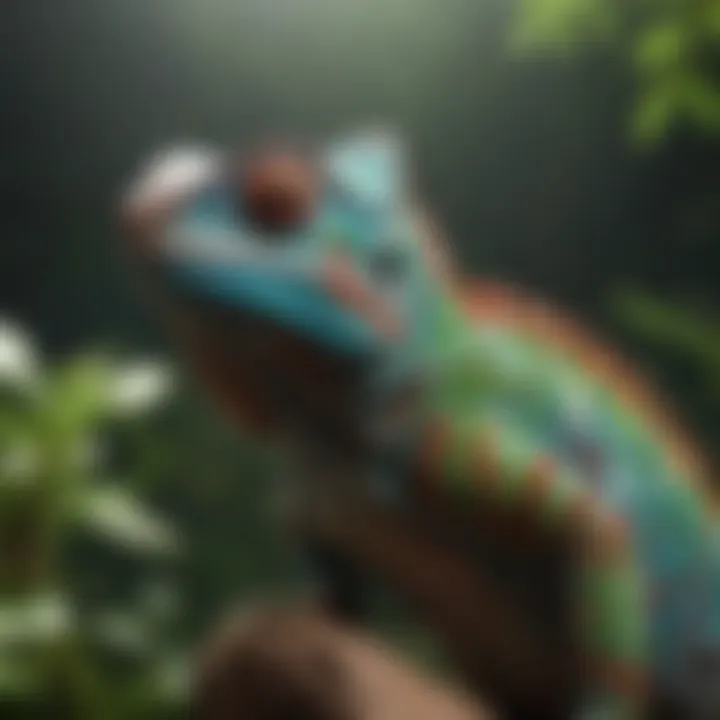Complete Care Guide for Panther Chameleons


Intro
Caring for a panther chameleon is a fascinating journey that comes with its own set of challenges and rewards. These vibrant creatures, known for their striking colors and unique personalities, require special attention to thrive in captivity. This guide aims to empower pet owners with the knowledge necessary to create a joyful and healthy environment for their chameleon companions.
Understanding their natural habitat, pinpointing their specific dietary needs, and managing health issues are vital components of chameleon care. By delving into each aspect of their care, we pave a path for our pets to lead happier, healthier lives.
Understanding Your Pet
Pet Behavior Basics
Panther chameleons are not just passive observers of life; they exhibit a range of behaviors that reflect their environment and emotional state. Observing these behaviors can help you understand when your chameleon is stressed or comfortable. For instance, when a chameleon starts to display darker colors or hides more than usual, it could be a sign of discomfort or illness. Understanding these subtle cues is like learning a whole new language; the more you know, the better you can respond.
Common Breed Characteristics
The panther chameleon, scientifically known as Furcifer pardalis, shows a rich variety of colors based on its geographic origin. These range from brilliant blues to vibrant reds and greens, each signaling its availability for breeding or establishing territory. A common characteristic among them is their ability to change color not only for camouflage but also to express mood and temperature changes.
Species-Specific Needs
Every species has its quirks, and panther chameleons are no exception. They thrive in environments that mimic their natural habitat, requiring ample sunlight, humidity, and a range of temperatures. Creating a proper environment isn’t just a good practice; it’s foundational for the well-being of your chameleon. Neglecting these needs can lead to stress-related health problems, significantly diminishing their quality of life.
Pet Care and Maintenance
Feeding Guidelines
Caring for a chameleon means understanding its diet, which primarily consists of live insects. Crickets, roaches, and mealworms make the bulk of their meals, but variety is key to keeping them healthy. Dust these insects with calcium and vitamin supplements to prevent deficiencies, which can cause serious health issues.
Grooming Essentials
Grooming isn’t just about making your chameleon look good; it’s about health. Regularly checking their skin for signs of shedding issues or parasites is crucial. Generally, panther chameleons need assistance with shedding, which is a natural process. Providing rough surfaces like branches or rocks can help them properly shed their skin.
Hygiene Practices
Maintaining cleanliness in your chameleon's habitat is critical for preventing diseases. Regularly clean their enclosure and remove uneaten food and waste. This not only keeps your pet healthy but also creates a more pleasant environment for them.
Training and Development
Basic Commands and Skills
Training a panther chameleon may sound daunting, but reinforcing simple tasks like coming to you for food can be beneficial. Although they do not respond to commands like dogs or cats, establishing a routine can help familiarize them with human interaction.
Behavioral Training Techniques
Using treats to reward good behavior can go a long way. If your chameleon climbs onto your hand willingly, treat it with a small insect. Over time, this builds trust and enhances your bond.
Addressing Common Behavior Issues
If your chameleon is unusually aggressive or overly shy, it's essential to assess their environment. Stress factors, such as lack of space or improper temperature, can lead to behavioral issues. Making slight adjustments to their habitat can often mitigate these problems.
Health and Wellness
Routine Vet Check-ups
Schedule regular vet appointments for your panther chameleon, even if they appear healthy. Routine check-ups can catch potential health issues early. Make sure the veterinarian has experience with reptiles, as their bodies function quite differently than other pets.
Vaccination Needs
Currently, there aren’t any vaccination requirements for panther chameleons. However, maintaining a healthy habitat and ensuring proper nutrition can naturally prevent many illnesses.
Recognizing Signs of Illness
Being able to identify signs of illness is crucial. Symptoms to look out for include lethargy, weight loss, and abnormal coloring. If you notice any of these signs, don’t hesitate to consult a vet, as prompt attention can be the difference between recovery and complications.
Enrichment and Activities
Indoor vs. Outdoor Activities
While indoor activities are essential for stimulation, allowing your chameleon supervised time outdoors can be immensely beneficial, provided the environment is safe. Just be aware of temperature fluctuations and potential predators.
Interactive Toys and Games


Although chameleons might not play in the traditional sense, providing branches to climb or hiding places can stimulate their natural instincts. Some chameleon owners even use feeding puzzles that promote activity during mealtime.
Socialization Opportunities
Carefully introducing your chameleon to various environments and people can help them adapt better. However, be cautious; not every chameleon is friendly and some may need more time to adjust than others.
Understanding Panther Chameleons
In the realm of exotic pets, the panther chameleon stands tall as one of the most captivating choices. Understanding these remarkable creatures lays the groundwork for their proper care, which ensures that both the pet and the owner enjoy a harmonious relationship. This section dives into the essence of the panther chameleon, covering critical aspects that anyone thinking of adopting one should know. Knowing their personality, natural environment, and unique physical traits can lead to a more enriched experience for both parties. Hence, this part is invaluable for new and seasoned owners alike.
Overview of the Species
The panther chameleon (Furcifer pardalis) is a vibrant reptile native primarily to Madagascar. These lizards are known for their dazzling colors and dynamic personality. They are typically medium-sized, with males generally reaching lengths of around 18 inches, whereas females are smaller, measuring about 10 inches. One cannot help but admire their ability to change colors, which serves various purposes, including camouflage, communication, and temperature regulation. An essential takeaway is that each chameleon is unique—different regions in Madagascar produce different color patterns, leading to a variety of color morphs.
Natural Habitat and Range
Panther chameleons thrive in a variety of habitats in Madagascar, including tropical forests, scrublands, and even highland areas. They prefer areas with ample foliage to allow them to hunt for food and bask in the sunlight. In the wild, they are known to be tree-dwellers, adept at moving gracefully among branches. Understanding their natural habitat is crucial for setting up their living space in captivity. Mimicking their natural conditions—such as appropriate humidity and temperature—helps provide an ideal environment, which in turn supports their overall health and behavior.
Physical Characteristics
A well-rounded appreciation of panther chameleons includes their striking physical features. They sport a unique set of colors ranging from brilliant blues, greens, and oranges, depending on their mood, health, and environmental conditions. Males are especially vibrant and can exhibit bold patterns that are not only breathtaking but also an essential part of their communication and mating rituals.
Moreover, their body structure is quite fascinating. With their protruding eyes that can move independently, they have excellent depth perception, enhancing their abilty to spot prey. Their prehensile tails and zygodactylous feet allow for a firm grip on branches, making them agile climbers. These characteristics make them a joy to observe, as well as a compelling subject for enthusiasts who wish to engage with a remarkable species.
"Understanding the panther chameleon is not just about being a pet owner; it’s about being a steward of a fascinating piece of biodiversity."
Recognizing their needs and innate behaviors is akin to reading a map that leads to an enriching journey. Therefore, the section about understanding panther chameleons forms a cornerstone of any successful care strategy.
Setting Up the Habitat
Creating an adequate living space for a panther chameleon is arguably one of the most vital aspects of their care. It's more than just a box with some decorations; it’s about crafting a tranquil, stimulating environment that mimics their natural habitat. A well-thought-out habitat can mean the difference between a healthy, active chameleon and one that is stressed or sick. Let's talk about the crucial components of setting up a good home for these unique reptiles.
Choosing the Right Enclosure
The enclosure is the foundation of your chameleon's habitat. When selecting one, consider the dimensions carefully. A tall, well-ventilated terrarium is often recommended, as these creatures prefer to climb and explore vertically. Aim for an enclosure that is at least 2 feet high for an adult panther chameleon.
Materials also matter; glass enclosures provide good visibility and are easy to clean, while screen cages allow for better airflow. You need to balance security with visibility, as chameleons can stress easily with too much movement visible around them.
Temperature and Humidity Requirements
Getting the temperature and humidity right is essential for a chameleon's wellbeing. A basking area with temperatures around 85-90°F is crucial for them to absorb heat. Meanwhile, the cooler side of the enclosure should be around 70-75°F. You can achieve this with heat lamps and by placing them strategically.
Humidity needs to be maintained at around 40-70%, depending on the specific chameleon you're keeping. Regular misting can help to reach this range. A hygrometer will come in handy here to measure humidity levels accurately.
Lighting Essentials
Chameleons thrive in bright light, so it's important to provide full-spectrum UVB lighting. This mimics their natural sunlight and aids in their ability to metabolize calcium. It's wise to replace these bulbs every 6-12 months, as their UVB output diminishes over time, even if the light still appears functional.
Make sure to create a light cycle that reflects day and night—typically, 12-14 hours of light per day works well for them. This cycle mimics their natural habitat and can positively influence their health and mood.
Furnishing the Habitat
Furnishing your chameleon's environment is about more than just aesthetic pleasure; it creates a natural, engaging space for your pet to explore. Consider the following subcategories:
Plants and Hides
Plants are not merely decorative but serve a much deeper purpose. Live plants like pothos or ficus are great choices, providing both hiding spots and surfaces for climbing. They also contribute to the humidity levels, creating a mini-ecosystem within your chameleon's enclosure.
Hides are crucial, particularly for adult chameleons who may prefer solitude from time to time. Using dense foliage or specially-designed hides helps them feel secure, reducing stress levels and promoting overall health.
Branch Structures
Adding a variety of branch structures is key. Chameleons are highly arboreal creatures, and a well-structured environment allows them to exhibit natural climbing behaviors. Use different thicknesses and heights to challenge and encourage your chameleon’s agility.
Just ensure the branches are safe, untreated, and cleaned before introducing them to the habitat. Some branches can rot or harbor pests if they’re not the right kind.
Water Sources
Water availability is paramount. Chameleons are often more inclined to drink droplets from leaves instead of standing water. Thus, a simple drip system or a daily misting will encourage proper hydration. You might also include a shallow dish for occasional bathing, but ensure it’s not too deep to avoid drowning risks.
Ensuring a reliable water source will help maintain hydration as well as proper body function. It’s also wise to use a water conditioner to eliminate harmful chemicals.


Anytime you set up the habitat, take time to observe your chameleon and tweak its surroundings until it seems comfortable and content. It might require some trial and error, but it's worth it for their health.
Dietary Needs
Understanding the dietary needs of panther chameleons is fundamental to their overall health and well-being. Just like humans, these remarkable creatures require a balanced diet to thrive. If the wrong food goes in, it can lead to a host of health problems, which can be tough on both the chameleon and its owner. Hence, recognizing what a panther chameleon needs nutritionally cannot be overstated.
Understanding Nutritional Requirements
A panther chameleon’s diet primarily consists of live insects and some plant matter. These reptiles are essentially insectivores, meaning their bodies are adapted to consuming a variety of insects. Proper nutrition impacts their color vibrancy, growth rate, and immune system function. Without a proper balance, your chameleon can become lethargic, moody, or even suffer from metabolic disorders. Each nutritional component plays its part:
- Proteins from insects help in muscle development and overall body function.
- Vitamins and Minerals, particularly calcium and phosphorus, are crucial for bone health.
- Hydration from both water and the moisture found in food is necessary for digestive processes.
Feeding Schedule
Consistency is key when it comes to feeding your chameleon. Establishing a regular feeding schedule helps regulate their metabolism and reduces stress. Adult panther chameleons typically eat every other day, while younger chameleons may require feeding every day due to their rapid growth. Generally, you want to follow this pattern:
- Juveniles: daily feeding of insects
- Adults: every other day
Be sure to observe their eating habits; if your chameleon is refusing food, it could signal health issues or an unsuitable habitat.
Types of Food
Caterpillars
Caterpillars are a generally popular choice among chameleon owners due to their high protein content and fat reserves. These squishy delicacies provide the necessary nutrients that chameleons need, especially during growth phases. One unique characteristic of caterpillars is their moisture content, which aids in hydration. However, they must be fed in moderation as their high fat content could lead to obesity if overconsumed.
Crickets
Crickets are staple food for panther chameleons. They are accessible and relatively easy to breed at home. One notable trait of crickets is their ability to keep moving, which encourages your chameleon’s natural hunting instincts. However, it's essential to gut-load crickets before offering them, ensuring they’re full of nutrients. Just keep an eye on the size—too large, and they risk injury to the chameleon.
Fruit and Vegetables
Though chameleons primarily feast on insects, adding small amounts of fruits and veggies can round out their diet. Leafy greens like collard greens or dandelion leaves can provide vitamins and hydration. Certain fruits like papaya or mango offer additional nutrients. Nonetheless, be wary of citrus fruits as they can upset a chameleon's stomach. The key here is moderation; don't let these choices overshadow their main insect diet.
Supplements and Vitamins
Most pet owners might think feeding insects covers all bases, but that’s where supplementation comes into play. Vitamin D3 and calcium supplements are crucial, especially in captivity since chameleons may not get enough UVB exposure to synthesize these nutrients. A commonly recommended approach is to dust insects with calcium powder a few times a week and provide a multivitamin once a month. This method ensures your chameleon gets the right nutrients without overloading them.
Overall, understanding dietary needs is a multifaceted endeavor involving choosing the right food, feeding schedule, and supplementation. Owners must remain vigilant and responsive to their chameleons' changing needs, ensuring their four-legged companions lead happy, healthy lives.
Behavioral Considerations
Understanding the behaviors of panther chameleons is crucial for anyone wanting to maintain a healthy environment for their colorful pet. Their behavior sheds light on their needs, giving owners insight into when they might be stressed, happy, or unwell. Observing these creatures can be a window into their health, stability, and overall happiness.
Understanding Chameleon Behavior
Chameleons are unique creatures, and their behavior is as fascinating as their appearance. Unlike many pets, they don’t express affection in overt ways. Instead, they show their feelings through colors and actions. For instance, a panther chameleon often displays a vibrant array of colors when content or excited, while duller hues might indicate stress or discontent.
Chameleons typically exhibit a behavior known as basking. They might sit still under a heat lamp, soaking up warmth, which is vital for their digestion and metabolism. On the flip side, if you notice them pacing or trying to hide, it could suggest anxiety due to changes in their environment or health issues.
Furthermore, it's interesting to observe their territorial behavior—especially during mating season. Male panther chameleons can display aggressive postures when they encounter another male, showcasing their colors and puffing up as a signal of dominance.
Signs of Stress or Discomfort
Every pet has its telltale signs indicating when something is off, and panther chameleons are no exception. Understanding these signals can help owners address potential issues before they escalate into serious health problems.
Some common signs of stress include:
- Color Change: If your chameleon turns dark or overly muted, it may be experiencing stress.
- Hiding: Excessive hiding is often a reaction to feeling unsafe or threatened.
- Pacing: If your chameleon is constantly moving around, it might indicate frustration or discomfort from its surroundings.
- Refusal to Eat: A lack of appetite can be alarming. It often signals that something isn’t quite right.
Monitoring these behaviors can ensure a long, healthy life for your pet.
"Stress in chameleons can lead to severe health issues. Therefore, a keen eye on your pet’s behavior can be a lifesaver in the long run."
Handling Techniques
Many pet owners are eager to interact with their chameleons, yet it’s important to approach handling with care. Panther chameleons are sensitive animals. They don’t take kindly to rough treatment or sudden movements. Here are some effective handling techniques:
- Approach Slowly: Your chameleon may view fast movements as a threat. Gently approaching helps to build trust.
- Use a Stick or Branch: Instead of grabbing your chameleon, you can use a stick or branch to encourage it to climb on. It mimics their natural behavior and can make the process less stressful for them.
- Limit Frequency: Frequent handling isn't necessary and can cause discomfort. Only handle your chameleon when absolutely necessary, like during health checks or cleaning its home.
- Be Aware of the Signals: If your pet seems to be trying to escape or shows signs of stress, it's best to put it back in its habitat.


By keeping your handling sessions short and positive, you can help assure your chameleon feels secure, which is essential for its well-being.
Health Care Practices
Caring for panther chameleons goes beyond just providing a proper habitat and balanced diet; a crucial part of keeping these fascinating creatures healthy lies in understanding health care practices. Like any pet, chameleons can run into health hiccups, and being aware of these can spell the difference between a lively pet and one that’s struggling. Addressing health issues early, practicing preventive measures, and ensuring regular veterinary care are all essential elements that empower owners to maintain their chameleons’ well-being.
Common Health Issues
Respiratory Infections
Respiratory infections in panther chameleons are more common than many might think. These infections can stem from various factors, but they often result from high humidity levels combined with inadequate ventilation in the enclosure. It's critical to monitor the breathing patterns of your chameleon; wheezing or labored breaths are tell-tale signs that something isn't right.
A key characteristic of respiratory infections is their ability to escalate quickly. This often makes them a focus in chameleon health care discussions. Identifying the infection early can lead to successful treatment, usually involving antibiotics prescribed by a veterinarian.
What's especially unique about respiratory infections is that they can also indicate larger environmental issues. For instance, consistent humidity levels must be controlled, as too much moisture can foster bacterial growth. By keeping an eye on the setup, you can prevent respiratory issues and foster a healthier habitat for your chameleon. That’s the beauty of being proactive in pet care.
MBD (Metabolic Bone Disease)
Metabolic Bone Disease is another serious condition for panther chameleons that can arise from improper calcium and vitamin D3 intake. The troubling aspect of MBD is that it often goes unnoticed until it manifests visibly in the chameleon's bones, leading to severe deformities or difficulty in movement. Regular checks on your chameleon's diet to ensure adequate calcium and UV exposure can reduce the chance of this condition appearing.
The primary feature of MBD lies in its systemic nature; it's not just about the loss of bone density—it can affect other bodily functions too. Catching it early often requires careful observation of your pet’s behaviors, as lethargy or trembling may be indicators. The beauty of learning about MBD is understanding how, with the right diet and proper supplementation, you can prevent potential long-term issues and ensure your chameleon thrives.
Preventive Care
Engaging in preventive care can not only enhance the quality of life for your chameleon but also save you potential heartache down the road. Basic preventive measures include creating a stable habitat with accurate temperature and humidity levels, regular cleaning of the enclosure, and routine monitoring of your chameleon’s eating habits and behavior. A well-maintained environment will significantly reduce the risk of infections and diseases.
Regularly have your chameleon checked for parasites, too. It’s a quicker fix than one might think; a simple fecal examination can help catch any unwelcome guests early. Awareness of these preventive steps makes chameleon ownership more fulfilling as it leads to a healthier relationship between you and your vibrant companion.
Veterinary Visits
Veterinary visits are indispensable in the broader picture of chameleon care. These visits should not be viewed as a hassle, but rather as opportunities to ensure that your pet is living its best life. Regular check-ups with an exotic vet can catch potential health issues early and provide vital vaccinations if necessary.
During your visits, don’t shy away from asking questions about anything that’s been troubling you or your pet. A knowledgeable vet can offer insights into not just physical health, but also behavioral aspects, providing a holistic view of your chameleon’s well-being. A strong vet-pet relationship can facilitate better care over time, laying the groundwork for a happy and healthy chameleon.
Breeding Panther Chameleons
Breeding panther chameleons can be a rewarding experience for pet owners who wish to expand their knowledge and deepen their engagement with this fascinating species. It involves understanding the delicate balance of their natural instincts and needs while ensuring that the process is safe and nurturing for both the parents and their hatchlings. This segment will dive into critical aspects of breeding, including mating behaviors, incubation conditions, and hatchling care, all of which will contribute to a successful breeding experience.
Understanding Mating Behaviors
Mating in panther chameleons showcases a dance of colors and movements that is truly captivating. During the breeding season, which is typically in the spring, male chameleons often become more vibrant, displaying intense patterns to attract females. These displays are not merely for show; they serve as signals to indicate fitness and readiness to breed.
Females, on the other hand, are a bit more cautious. Their decision on whether to mate can be influenced by several factors, such as the size of the male and the surrounding environment. Observing a male’s territorial behaviors can provide insights; aggressive displays may deter females, while a more respectful approach may enhance the chances of successful mating. After a male successfully courts a female, copulation can occur, lasting anywhere from 15 minutes to an hour. It's crucial for breeders to monitor these interactions closely, as signs of aggression or stress in either chameleon should be addressed immediately.
Incubation Conditions
Once mating has occurred, the female will often lay eggs approximately 30 days later, depending on her health and environmental conditions. This is where setting the right incubation conditions becomes vital.
The eggs should be placed in a moist substrate, such as vermiculite or perlite, which helps maintain humidity. The recommended temperature for incubation falls between 72 to 78 degrees Fahrenheit. A consistent environment during this period is essential, as fluctuations can result in developmental issues or even egg mortality. Moreover, it may take around 4 to 9 months for the eggs to hatch, so patience is key. During this time, minimal disturbance to the setup will help ensure the best outcome for the embryos developing inside.
Caring for Hatchlings
Once the hatchlings finally make their appearance, a new world of challenges and joys begins. Newly emerged panther chameleons are tiny and fragile, measuring just a few inches in length. Proper care at this stage is critical to ensure they thrive, so here are a few key pointers:
- Environment: A smaller enclosure should be setup specifically for hatchlings, as this will help them feel more secure.
- Temperature and Humidity: Maintain a temperature of around 80-85°F with a good level of humidity. A well-placed, shallow water dish can provide hydration during the first few days.
- Diet: Hatchlings should be fed appropriately sized insects, such as pinhead crickets or fruit flies. It’s essential to dust these with calcium powder to support healthy growth.
Regular feedings every other day will help ensure that they get the nutrients needed for optimal growth. After a few weeks, they can start eating slightly larger prey.
In essence, breeding panther chameleons isn’t simply about reproduction, but about understanding the nuances of their behavior and care needs. With the right conditions and attention to detail, not only can you foster a healthy breeding environment, but also have the opportunity to witness the full life cycle of these vibrant creatures.
Closure
As we tie up the loose ends on how to care for panther chameleons, it’s clear that understanding these fascinating creatures involves more than just providing food and water. Panther chameleons are not only pets; they are complex beings that thrive in environments reflecting their natural habitats. Creating a suitable habitat, maintaining a balanced diet, and being alert to their behavioral signs shape the foundation of a happy and healthy chameleon.
Summary of Care Practices
In summary, the care practices for panther chameleons focus on several key areas:
- Habitat Setup: Ensure the enclosure mimics their natural environment with ample space, proper temperature control, and humidity levels.
- Diet and Nutrition: A varied diet that includes live insects and an occasional supplement is crucial for their health. Regular feeding schedules should be followed to maintain proper energy levels and growth.
- Health Monitoring: Keep an eye out for signs of stress or illness, addressing any issues promptly with preventive care and veterinary visits as necessary.
- Behavioral Understanding: Taking time to observe and interpret your chameleon’s behaviors can deepen your bond and allow you to respond to their needs effectively.
Each element plays a vital role not just in their survival but in promoting their well-being and happiness. By following these practices diligently, you’re setting the stage for a thriving creature that enlightens your life with its unique personality and colors.
Encouragement for Enthusiasts
For all you enthusiasts looking to embark on or continue your journey with a panther chameleon, remember that patience and continuous learning are your best friends. Every chameleon has its quirks; take the time to learn what makes your pet tick—this will enrich both your experience and theirs. Join communities on platforms like reddit.com and facebook.com where fellow chameleon owners share tips, tricks, and tales of their adventures. This support can be invaluable as you navigate the ups and downs of chameleon care.
With the proper care and understanding, your panther chameleon will not only survive but truly thrive. Embrace the journey, and enjoy this colorful companion's vibrant personality and captivating behaviors. Remember, it’s not just about keeping a pet; it’s about fostering a relationship that reflects mutual respect and appreciation.







